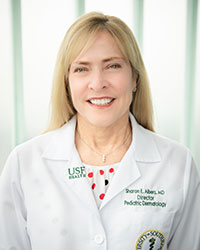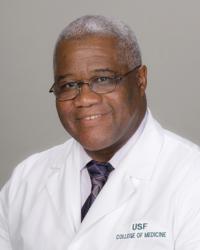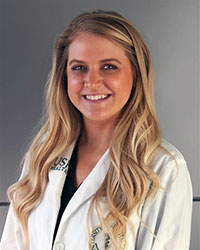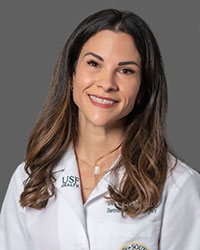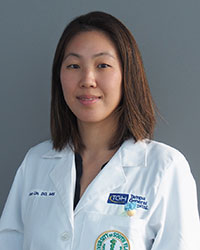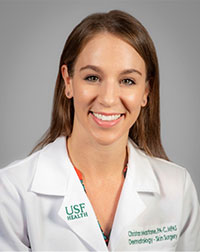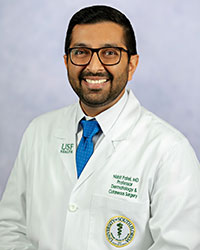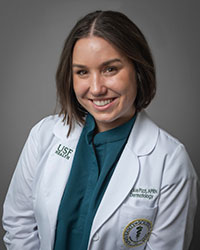Dermatology & Cutaneous Surgery
Acne and Rosacea
Acne and rosacea are two common skin conditions that are often confused for each other and can lead patients to misdiagnose themselves when looking for solutions. A visit to a specialist will clarify the condition and treatment. Our experts at USF Health are sensitive to the needs of our patients and address all aspects of our patient's care. We understand that healthy skin has a positive impact on our physical health as well our emotional well being. We are dedicated to ensuring that all of our patients receive the best positive outcomes and are confident with the condition, feel and look of their skin.
What is Acne
Acne is a skin condition that causes clogged pores called blackheads and whiteheads, inflamed pustules called pimples, and deeper lumps called nodules.
Acne occurs on many parts of the body, including the face, neck, chest, back, shoulders, and upper arms. People of all ages can have acne and 25 percent of adults will experience acne throughout their 20s to 40s. About 90% of teenagers develop the condition, as do nearly 50% of adult women.
Acne tends to resolve overtime without treatment but, if left untreated, it can leave permanent scars. Therefore, acne should be treated and managed.
What is Rosacea
Although referred to as ‘adult acne,’ rosacea often starts as an exaggerated flushing response to hot drinks, spicy foods, alcohol, caffeine, and sunlight. This flushing can cause an appearance of permanent vessels on the face (telangectasias).
Some people also develop ‘pimples’ on a background of flushing, and a small number (primarily men) develop overgrowth of the tissues of the nose (rhinophyma).
Frequently Asked Questions
-
Acne is caused by caused by clogged pores and follicles as a result of one or more of the following:
- Hormones
- Over production of an oily secretion called sebum
- Overactive sebaceous gland
- Presence of a bacteria called Propionibacterium acne
- Your body’s inflammatory process
-
Acne begins to develop about two to three weeks before it appears on the skin's surface. It starts in the sebaceous follicles and pores. Deep within the skin the sebaceous glands are producing sebum, the oil that keeps the skin moist. As the skin renews itself, the old cells die and mix with the skin's natural oils and slough off. In acne patients, those dead skin cells and oil clump together and clog the pores and follicles trapping bacteria within the follicle, resulting in acne.
-
- Washing your face once or twice a day with a medical grade mild cleanser or a medicated cleanser.
- Consulting a dermatologist or skin care specialist about what skin care products and make-ups are right for your skin.
- Prescription topical creams, gels, or lotions with vitamin A acid-like drugs, benzoyl peroxide, or antibiotics can help unblock the pores and reduce bacteria.
- Microdermabrasion or chemical peels, which may help remove the upper layers of the skin to unblock the pores and follicles and stimulate new skin growth.
- Oral antibiotics, which are often prescribed in conjunction with topical treatments to decrease bacteria and improve outcomes.
- Changing birth control pills, if the acne is hormonal related.
- Laser skin resurfacing by a dermatologist, which can treat acne scaring.
-
Rosacea is an extremely common condition in the United States, affecting primarily Caucasians of Northern European ancestry. Its onset is usually in early to middle adulthood.
-
There are many effective treatments for rosacea, depending on the stage and severity of your condition.
- For those with primarily flushing, avoiding things that trigger episodes is the first line of defense. There are also topical treatments commonly used in this stage of the disease.
- For those with severe ‘pimple’ outbreaks, a course of an oral antibiotic, typically a tetracycline, is used. The antibiotic is often continued for several months.
- In the treatment of rhinophyma, prevention is key, which helps avoid complications. If rhinophyma has already developed, there are procedures for paring down the skin on the nose, typically performed by a plastic surgeon.
- Laser removal of dilated vessels on the nose and face (telangectasias) due to rosacea is also an effective treatment. The procedure is fast, results are seen immediately in many cases, and patients are typically very pleased with the results. If laser treatment is not for you, covering these vessels can be accomplished using a makeup with a green base.
Meet Our Experts
-
Josef Doenges, MD
Josef Doenges, MD
